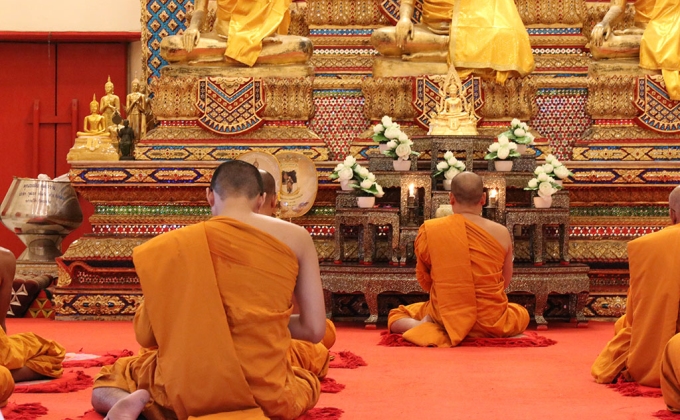Buddhism was founded in northeastern India in the 6th century BCE by the historical Buddha Shakyamuni, who taught in the region for about 45 years. The main Buddhist movement in India survived for over a thousand years and began a gradual decline from the 7th century CE, although the great Buddhist universities and monastic centers continued to flourish for many more centuries. In the 11th century, the great Buddhist libraries and universities were destroyed by the Muslim invasion of India. By the 13th century, Buddhism had disappeared from northern India, where it had originated, only to return in the 19th century.
First Phase: Spread of Hinayana
Second Phase: Spread of Mahayana
Around the 1st century CE, the Mahayana tradition began to develop. The great university of Nalanda was founded in the 2nd century CE. However, the development of Mahayana Buddhist thought and scholarship was already well underway before that time. The great Dharma King and Mahasiddha Nagarjuna (150-250 CE) founded the Madhyamaka school in the 2nd century. In the 4th century, Dharma King Asanga founded the Yogachara school. These two lineages formed the basis for the Mahayana teachings that then spread to Pakistan, Afghanistan, Indonesia, and along the Silk Route to China (1st century) and northern Vietnam, and further to Korea (4th century) and Japan (6th century).
Bodhidharma went to China from India in 526 CE and founded the later Chan or Zen school. By the late 7th century, the Pure Land, Tian-Tai, Hua-Yen, and Fa-Hsiang schools had developed in China. Buddhist influence in China reached its peak in the 10th century but remained an essential part of Chinese culture, although the communists attempted to systematically suppress it. Afghanistan and Indonesia became Muslim-dominated countries where Buddhism was completely erased. Some of the great testaments to Mahayana Buddhism from this time still exist in these countries, mostly as tourist attractions now. The gigantic Buddha statues destroyed by the Taliban regime in Afghanistan in 2001 and by other Islamist groups in Pakistan in 2007 date from this phase.
Third Phase: Spread of Vajrayana
The esoteric practice of Mahayana or Tantra was already well established in India by the 7th century. The esoteric or Vajrayana teachings were transmitted to Tibet, Bhutan, and China in the 8th century, later reaching Japan (early 9th century), Mongolia (13th century), and back to India and Nepal (20th century) with the Tibetan diaspora. There is also evidence of a transmission of these teachings to Southeast Asia, particularly My anmar. In the 8th century, the Indian Dharma King and Mahasiddha Padmasambhava traveled to Tibet. Around the same time, the Vikramashila University was founded in India.
Dharma King Atisha, one of the foremost teachers at Vikramashila, went to Tibet in 1042. Marpa and Drokmi traveled from Tibet to India in search of the Dharma in the 11th century. Much of the Indian Buddha-Dharma from this time was transmitted to Tibet before being destroyed by the Muslim invasion in the 11th and 12th centuries. The Muslim conquerors looted the great monastery university of Nalanda in 1197 and Vikramashila in 1203.
About 500 years after Padmasambhava’s arrival, many people in Tibet attained liberation. The highest Dharmas were openly taught, sometimes even to those unqualified to receive them. In the 14th century, Dharma King Tsongkhapa (1357-1419), an emanation of Manjushri, restored monastic discipline in Tibet and corrected the false teachings that had developed due to the many false tulkus in Tibet and those who had fled from India. The Dharma of the Buddha that developed in Tibet is of great power. In 1950, the Chinese communists invaded Tibet, suppressed Buddhism, destroyed monasteries and temples, and persecuted monks and nuns who they saw as parasites on the working populace. Many of the surviving tulkus and lamas fled to India, Bhutan, Nepal, and the West, while many of those left behind were imprisoned or forced into other occupations, mostly hard labor, in what had once been Tibet. After the cultural revolution, some were allowed to return and rebuild their monasteries, but only with a handful of monks and mostly as tourist attractions.
Fourth Phase: Spread to the West
18th-19th Century CE – The transmission of Buddhism to the West began with the emigration of Buddhists from various Asian countries to the West in the mid-19th century, and with people from the West traveling to Japan, Korea, China and Southeast Asia in search of the Dharma, later returning to teach what they had learned. As in Tibet after the massive emigration from India in the medieval period, there was also a proliferation of false teachers in the West, mainly teaching for their livelihood and lacking an authentic lineage or correct Buddha-Dharma.
His Holiness Dorje Chang Buddha III came into this world to show living beings that the power and wisdom of the true Buddha-Dharma that Buddha Shakyamuni possessed can still be attained in this age. His Holiness also came to correct the mistakes that had arisen in the various transmissions over time, and to teach the highest Dharmas of Buddha Shakyamuni, some of which had not yet been transmitted. His Holiness said that only 30% of the Buddha-Dharma that Buddha Shakyamuni received during His lifetime was taught. The Nagas received about 70% of the Dharma from Shakyamuni in their palace beneath the sea. It is important to remember that Buddha Shakyamuni learned this Dharma from his teacher, Buddha Dipankara, another manifestation of Dorje Chang Buddha.
In the 8th century, the Dharma King Padmasambhava prophesied that “when the iron eagle flies and horses run on wheels, the Tibetans will be scattered all over the earth and the Dharma will go to the land of the red faced people.” Previously, Buddha Shakyamuni stated in the Sutra “Request of the Girl with the Makelless Light” that his Dharma would spread 2,500 years after his passing in the “land of the red faced people.” The indigenous peoples of the Americas have long been regarded as the “red” race, although some think this refers more to the “pinkish-grey” color of Westerners. In any case, these prophecies appear to be accurate.
The map of transmission lineages shows how Buddhism has evolved and been handed down over time.
What this diagram does not show are the so-called “Golden Ages” that were, in those lands, the time when Buddhism was at its height of influence. The art and poetic expressions of those eras still fascinate us today, whether the caves and grottos in India and China, Angkor Wat in Cambodia, the famous temple ruins in Indonesia, or the magnificent and sacred art and architecture throughout China and Japan.
Whenever Buddhism disappeared in one place, it reemerged in another culture, only to develop again in yet another form corresponding to the people living in that place at that time. At each point in history, great beings incarnated to make this possible. The West now has transmissions from all these great phases of Buddhism’s development, conveyed from many diverse cultures. The West now also has the true Buddha-Dharma of H.H. Dorje Chang Buddha III.
Image source
Map of Buddhist Expansion: Gunawan Kartapranata, CC BY-SA 3.0, via Wikimedia Commons
Learn more about Buddhism
Origin and development of Buddhism
Learn how Buddhism came to our world through Dorje Chang Buddha and Shakyamuni Buddha and how it has divided into different vehicles – Hinayana, Mahayana, and Vajrayana – over time.
Main Sects and Schools of Buddhism
Becoming a Buddhist: A Step-by-Step Guide
In order to build a Dharma practice and achieve the goal of Buddhism, the liberation from the cycle of birth and death, certain elements of Buddhist practice must be understood and correctly applied.



